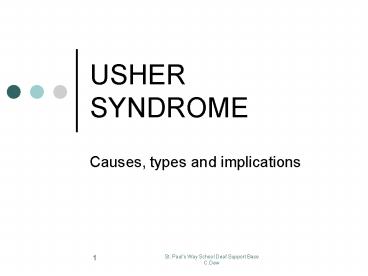USHER SYNDROME - PowerPoint PPT Presentation
1 / 22
Title:
USHER SYNDROME
Description:
USHER SYNDROME Causes, types and implications What is Usher Syndrome? A syndrome which affects both hearing and vision It is an inherited condition; often parents are ... – PowerPoint PPT presentation
Number of Views:1584
Avg rating:3.0/5.0
Title: USHER SYNDROME
1
USHER SYNDROME
- Causes, types and implications
2
What is Usher Syndrome?
- A syndrome which affects both hearing and vision
- It is an inherited condition often parents are
unaware that they both carry this faulty gene - It affects 3 6 of the deaf and partially
hearing population in the UK - At present there is no treatment for this
condition
3
Types of Usher Syndrome
4
Type 1 (USH1)
- Marked by profound deafness at birth and severe
balance problems. Many will not benefit from
hearing aids and so most will use sign language
to communicate. These children begin to develop
vision problems by the time they are 10 and
usually start with difficulty seeing at night
this progresses rapidly until blindness
eventually occurs.
5
Type 2 (USH2)
- Marked by moderate to severe hearing loss at
birth but no balance problems. Most of these
children benefit from hearing aids and will use
speech to communicate. The visual problems tend
to progress more slowly than in USH1 and are
characterised by blind spots that begin to appear
during the teenage years. Gradually, the vision
deteriorates to blindness.
6
Type 3 (USH3)
- These children have normal hearing and near
normal balance. They usually develop hearing
problems during their teenage years and become
deaf by mid to late adulthood. Night blindness
usually starts during puberty, blind spots appear
in early adulthood and the individual is usually
blind by mid adulthood.
7
Physical Signs
- (there is no way to predict timing or progression
of the vision loss) - Source Centre on Deafness, Illinois Deaf-blind
Services, Illinois
8
Night Blindness
- Difficulties seeing when coming in from bright
sunlight - Trips over things when light changes or light is
dim - Stays near a light in a dark room or at night
- Moves a speaker so light falls on face
- May want to enter a room before it is darkened
(cinema etc.)
9
Night Blindness (cont)
- Avoids conversations in a darkened area
- Whilst walking on the pavement, may appear to
stagger or lose balance after an oncoming car has
passed - Has problems reading under some lights or in
dimly lit areas
10
Glare sensitive
- Squints and shades eyes in bright lights or
fluorescent lighting - complains that the light
hurts his/her eyes - Likes to wear sunglasses even in buildings, but
especially in bright sunlight - Avoids participating in outdoor sports when the
sun is very bright - May appear dazzled when leaving a building and
going outside
11
Needs contrast
- Has difficulty reading light copies
- Often spills when pouring liquids
- Unable to see stars at night
12
Restricted field
- Startles easily
- Seems to hold eyes in a different direction when
looking at some things - Turns head while reading across a page
- Uses finger to mark place while reading
13
Restricted field (cont)
- Unable to find small objects that have been
dropped - Does not respond to verbal or non-verbal
communication from the left or right - Bumps into people, tables, and chairs
- Stumbles on stairs and curbs
14
Restricted field (cont)
- Is quiet in a large group or may edge to one side
when placed in a group - Frequently fails to understand or misses group
instruction. Often relies on friends for
information - May appear to ignore others standing by his/her
side - Prefers conversation at distances of 4 to 6 feet.
15
Problems with visual acuity
- Holds book close to eyes, or bends to read
- Places face close to desk while writing
- Sits near whiteboard
16
Balance problems
- Cannot ride a bicycle
- Is considered clumsy
- Loses balance easily in the dark
17
Other
- Frequently last in completing group activities
- May appear anxious in new surroundings
- Often last to enter the room
- May have some repetitive behaviour- appears to do
the same things in the same ways
18
Other (cont)
- May not participate in group activities
- Frequently hesitates at the top or bottom of
stairs - Avoids walking or running in unfamiliar areas
- Appears to be constantly visually scanning a
group
19
Classroom Adaptations 1
- Lighting should be adequate without glare
- Close curtains to minimise glare
- Windows should be behind students
- The teacher should never be in front of windows
- Avoid clutter on the walls and floor
20
Classroom Adaptations 2
- Wall colour behind the teacher needs to be a
solid colour - Floors and carpets should not be dark red or
brown - Furniture should be arranged to provide easy
movement in open space - Seat students where they are comfortable
-possibly front side so they can see the
whiteboard and other students in the class
21
Materials
- Print should be maximum contrast. Use 12 to 18
point type with non-glare (yellow) paper. - Students may need individual copies of graphs or
charts, or they may need time to examine these
charts close-up. - Tests may have to be adapted for individual use
and extra time allowed - Keep the whiteboard clean and use high contrast
colours
22
But remember to emphasise...
Source Sense































